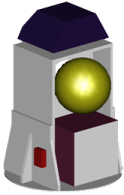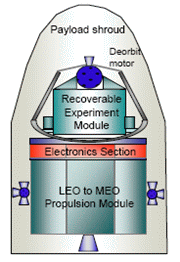Standardized Multi-Payload Carriers
A key objective of the Small Launch Vehicle Research (SLVR) project is the establishment of a suite of flight carriers that will possess standard interfaces to small orbital launch vehicle(s), and accommodate a flexible set of small spacecraft requirements for a diverse customer base.
MPE
Wallops has taken the first step on this element with the Multiple Payload Ejector (MPE). This carrier, currently under development, can provide accommodations for stand-alone spacecraft ranging from Cubesats to ESPA-class satellites with masses ranging from 2-400 pounds. The MPE offers the flexibility to trade mass, volume, and quantity of individual spacecraft, along with orbital altitude through the modular addition or removal of MPE segments.



MPEC

Concepts are currently under development for a second type of carrier that provides services to experiments rather than to stand-along spacecraft. This carrier, the Multi-Payload Experiment Carrier (MPEC) would offer a means to flight demonstrate components, boards, materials, and software systems in a space environment without the burden of developing a host spacecraft.
The MPEC would provide standard electrical, data, and mechanical interfaces and provide fixed experiment mass, volume, power, data, and thermal envelopes. Like the MPE, it would be modular, offering multiple stacking experiment sections.
The MPEC could fly as a stand-alone spacecraft, or potentially as a primary spacecraft atop a co-manifested MPE.
A likely customer of the MPEC would be researchers interested in higher radiation environments than provided in low Earth orbit (LEO). A propulsion module is anticipated that will move the MPEC from LEO to medium Earth orbit (MEO).
Freeflyer

A third carrier under construction, called Freeflyer, offers flight opportunities for experiments needing recovery from orbit. These may include biological, microgravity, or space-exposure experiments. This concept emulates the functionality of the Multiple Experiments Transporter to Earth Orbit and Return (METEOR) mission design sponsored by NASA in the early 1990s.
After an established period on orbit, the de-orbit motor would fire, allowing the carrier to reenter back to Earth for experiment recovery and analysis.
The Freeflyer carrier, like the MPE and MPEC, would use standard electrical, mechanical, and data interfaces, and require experiments to conform to fixed mass, volume, and thermal budgets. Customer needs for going to orbits higher than LEO, as well as small ELV capability, will be assessed during requirements definition.
The MPE, MPEC, and Freeflyer will jointly serve as a suite of carriers, offering a broad set of accommodations for different applications.
SLVR
- NASA Official: Bruce Underwood
- Curator: Brandon Wright
- Last Updated: February 13 2006
